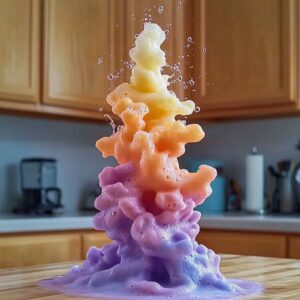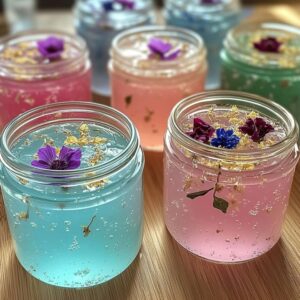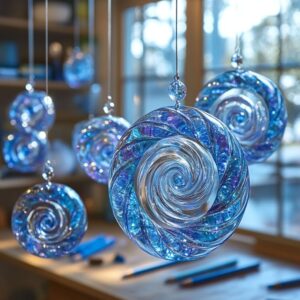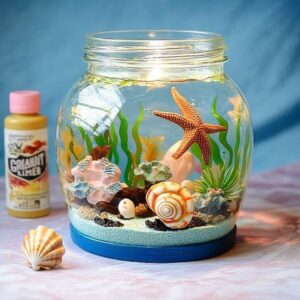Introduction
If you’re searching for a show-stopping, science-meets-snack creation, then this Watermelon Popping Boba recipe is exactly what you need. Not only does it burst with the refreshing taste of summer fruit, but it also showcases the magic of molecular gastronomy. Whether you’re planning a party, crafting a fun food science experiment with kids, or looking to enhance your drinks with a splash of creativity, this watermelon popping boba will deliver flavor, fun, and fizz in every juicy pop. Consequently, it’s a perfect combination of education and indulgence.
Why You’ll Love This Recipe
Surprisingly easy to make at home, this popping boba recipe transforms a few basic ingredients into something extraordinary. Because it’s based on a process called spherification, it offers both visual appeal and an exciting mouthfeel. Moreover, you control every aspect—from sweetness to color—ensuring your boba fits any drink, dessert, or dietary preference. For those who appreciate a hands-on kitchen activity, this recipe delivers the perfect blend of food science, art, and culinary creativity.
Ingredients
To get started, gather the following ingredients:
- 1 cup fresh watermelon juice (strained for smoothness)
- 1–2 Tbsp sugar or agave syrup (to taste)
- 1/2 tsp sodium alginate (a thickener used in molecular gastronomy)
- Optional: a drop of red or pink food coloring for vibrancy
- 2 cups cold water
- 1 tsp calcium lactate or calcium chloride (used for spherification)
Necessary Tools
Before diving into the fun, make sure you have these essential tools ready:
- Blender
- Fine mesh strainer or cheesecloth
- Measuring spoons and cups
- Mixing bowls
- Squeeze bottle or dropper
- Whisk or spoon
- Slotted spoon or small strainer
- Bowl of clean cold water (for rinsing boba)
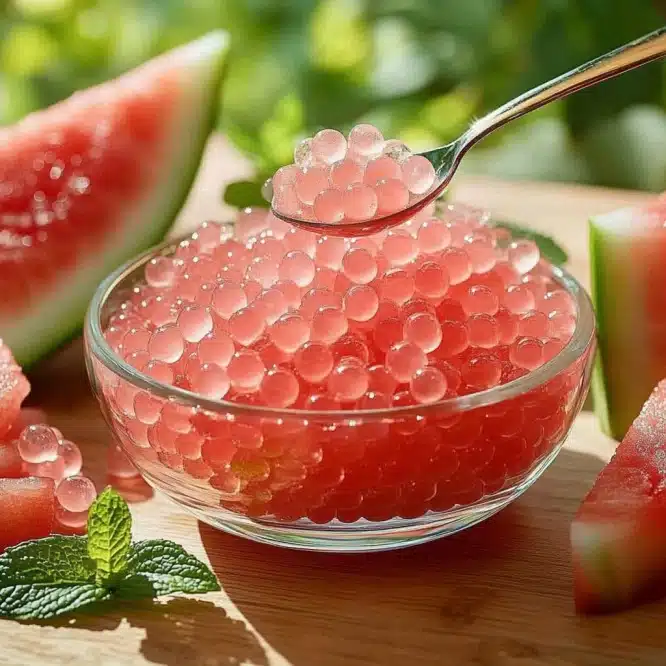
Ingredient Swaps and Additions
Flexibility is one of the most delightful aspects of this recipe. If you’re avoiding added sugars, you can skip the sweetener or use natural alternatives like stevia. Additionally, you might experiment with adding a hint of mint or lime juice to the watermelon base for a zingy twist. Meanwhile, other fruit juices—such as strawberry, mango, or kiwi—can replace watermelon entirely to create rainbow assortments of popping boba.
Step-by-Step Instructions
1. Blend the Watermelon Mix
First, combine the fresh watermelon juice, sugar or agave syrup, and sodium alginate in a blender. Blend thoroughly until the mixture is smooth and consistent. Afterward, let the mixture sit for 15–30 minutes to allow air bubbles to dissipate. This resting period is crucial because air bubbles can disrupt the formation of smooth boba spheres.
2. Prepare the Calcium Bath
Next, dissolve the calcium lactate or calcium chloride in a separate bowl with the 2 cups of cold water. Stir well until completely dissolved. This calcium bath is what triggers the spherification process, creating the outer gel layer around your boba pearls.
3. Form the Boba Pearls
Once the watermelon-alginate mixture is rested and smooth, transfer it into a squeeze bottle or dropper. Carefully drop it into the calcium bath, one drop at a time. Each droplet will instantly begin to form a jelly-like shell, encasing the liquid center. To create consistent pearls, keep your hand steady and use uniform pressure.
4. Let Set and Rinse
After forming the pearls, let them sit in the calcium bath for 30–60 seconds. Be careful not to exceed this time frame, or the pearls may become too firm throughout. Once set, use a slotted spoon or strainer to transfer them into a bowl of clean cold water. Gently swirl them around to rinse off excess calcium solution.
5. Serve and Enjoy
At this point, your popping boba are ready to use! Add them to beverages like lemonade, iced tea, or sparkling water for a fun surprise. Alternatively, you can layer them in fruit parfaits or yogurt bowls. Since the texture is best fresh, it’s ideal to serve them immediately.
Pro Tips for Success
- Use cold water for the calcium bath to maintain the ideal gelling temperature.
- Let your alginate mix rest to prevent foamy boba with air bubbles.
- Use a consistent dropper motion for uniform boba size and better visual appeal.
- Rinse thoroughly in clean water to remove any residual calcium taste.
- Avoid long soaks in the calcium bath, as the boba will harden instead of remaining burstable.
Serving Suggestions
You can serve your watermelon popping boba in many imaginative ways. For drinks, try adding a spoonful to lemonade, where the pop of flavor surprises with every sip. Additionally, use them to top smoothie bowls or ice cream sundaes for a colorful finish. If you’re feeling adventurous, pair them with coconut milk-based drinks for a tropical twist, or freeze them for a cool-texture treat.
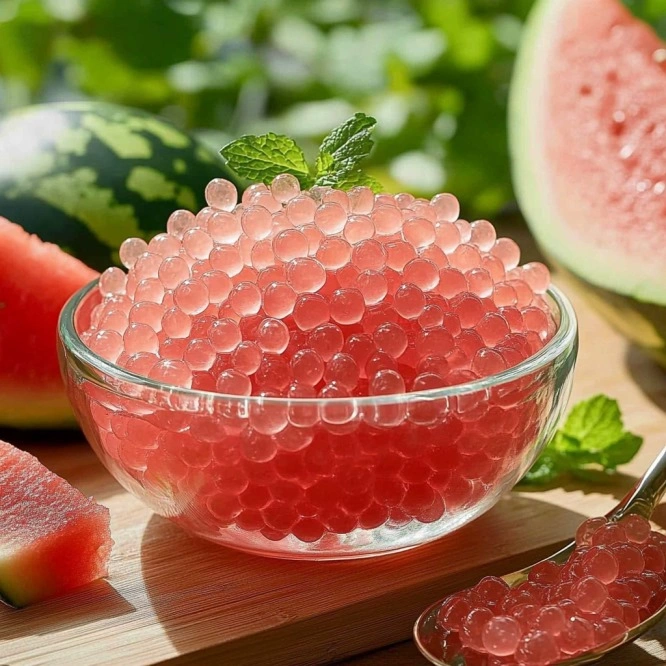
Storing and Reheating
Popping boba are best enjoyed fresh, but if needed, they can be stored in a sealed container in cold water in the refrigerator for up to 24 hours. Because they continue to gel over time, they may lose their popping effect if stored too long. Reheating is not necessary and can ruin the texture, so always serve cold.
Nutritional Information (Per Serving Estimate)
- Calories: 30–40 kcal
- Carbohydrates: 8g
- Sugars: 6g (varies by sweetener)
- Fat: 0g
- Protein: 0.2g
- Fiber: 0g
- Sodium: 5mg
- Vegan and gluten-free
FAQs
1. Can I use bottled watermelon juice instead of fresh? Yes, but make sure it’s 100% juice without added sugars or pulp, and strain it well before use.
2. What if I don’t have sodium alginate? Sodium alginate is essential for the spherification process. However, you can find it online or in specialty cooking stores.
3. Can I store the popping boba for more than a day? It’s best to use them within 24 hours. Beyond that, the texture may become rubbery.
4. What does popping boba taste like? It has a thin jelly-like shell with a burst of juicy liquid inside. The flavor depends on your fruit juice base.
5. Are there other liquids I can use for this recipe? Absolutely! Mango, kiwi, blueberry, and even herbal teas can be used for endless variations.
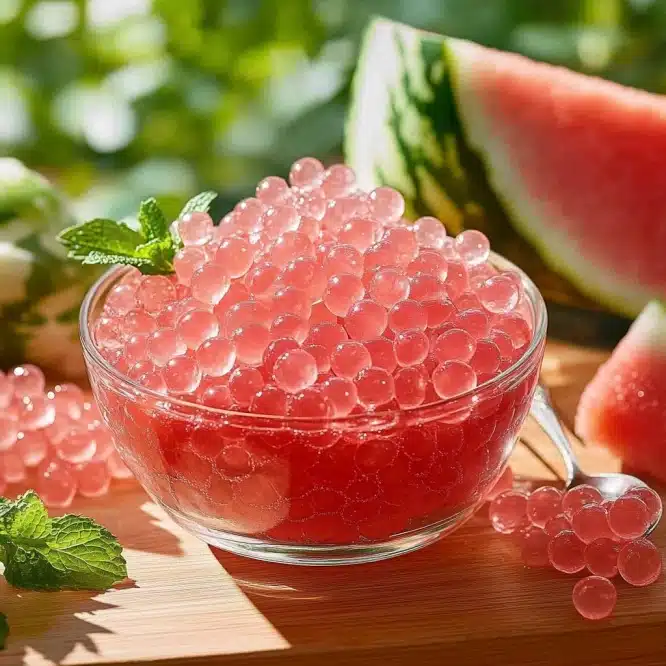
Conclusion
This Watermelon Popping Boba recipe offers a unique way to blend food, fun, and science in a single creation. Whether you’re introducing kids to the wonders of molecular gastronomy or just want to jazz up your summer drinks, this simple and satisfying DIY treat is sure to delight. For even more creative kitchen adventures, try pairing these with fruity lemonade popsicles, vibrant smoothie bowls, or bubble tea-inspired desserts.

